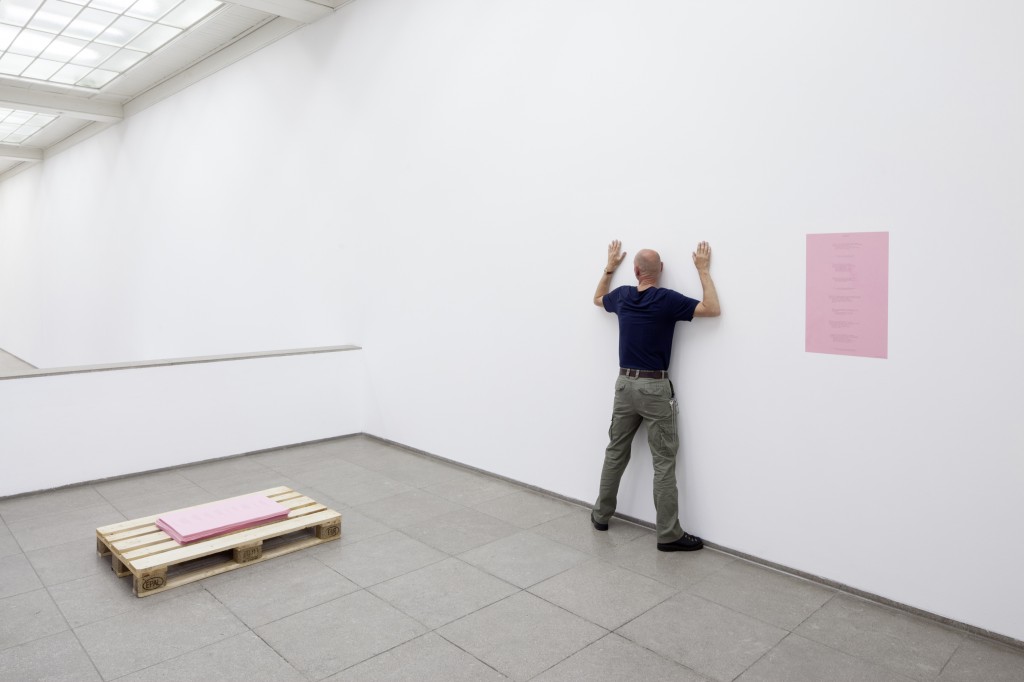Body Pressure: Hamburger Banhof
by Stephanie Cristello
“Press as much of the front surface of
your body (palms in or out, left or right cheek)
against the wall as possible.”
The white wall. This is the familiar construct that Bruce Nauman challenges, the container of the gallery itself – the material of the space that contains us, the viewer. The excerpt above is just one of a list of instructions contained within the text of his 1974 piece Body Pressure, a title that shares a name with the expansive survey exhibition currently on view at the Hamburger Bahnhof, in Berlin. Subtitled Sculpture Since the 1960s, the exhibition includes work by a number of internationally well-known artists, among them Paul McCarthy, Urs Fischer, and Friederike Pezold – Nauman as the centerpiece. The work consists of a palette, a stack of light pink paper, the type often used for official use, and inadvertently the viewer, and perhaps even less avertedly, the wall. The expectation is, of course, that viewers follow the instructions on the paper – implementing themselves within the piece, out of free will or by instruction, depending on how we choose to interpret Nauman’s authority. Authority is not, however, the point.

“Press very hard and concentrate on the image
pressing very hard.
(the image of pressing very hard)
press your front surface and back surface
toward each other and begin to ignore or
block the thickness of the wall. (remove
the wall)”
Although it is not, either, about the individual. The impulse instead surrounds an image that we cannot access unless precisely in our mind – it is an experiment in representation, of self-representation, in the realm of the imaginary. What we experience is ourselves in the lens of the other; we witness other viewers and their stance against the wall, and imagine ourselves in their place. They become an icon of the completed piece, which when we take part in as well, are reflections that act as visual models and reference points of how we ourselves are represented in the work. This representation, reflected in the imaginary, is the stance that figuration takes within the exhibition as a whole. The infracted, the fragmented, the illusory, though not romantic – this is the representation of the figure we can expect post-1960, a divided sense of self that reflects the subject as a distortion, instead of a mirror.
Such is the case with Pezold’s filmic sculpture, a series of nearly still black and white images stacked upon four monitors, almost equal to the height of the average viewer. The figure is translated as a set of flickering features, each becoming a symbol of their original use, serving no purpose other than to signify a lexicon of the body; wide eyes are on the top most screen, perfectly painted lips on the second, a female chest, and the indentation between the thighs, following. Perverse, though not sexualized, the piece gives a nod to Dada and collage, dwarfing certain elements of the figure, enlarging others in perspective – a column of misrepresentation. Similarly to Nauman, we interact with this representation as at once recognizable, and a mirage of what we see versus what we know. The tension between the potential for mutability pushes against the expectation of movement – between the photographic and the cinematic, while it remains trapped in its form. It is a certain kind of pressure that is prevalent throughout the selected works, not something enacted on the viewer, but activated by the viewer – an inherent pressure that the piece realizes within itself.

In What if the Phone Rings 2, by Urs Fischer, a perfect caricature of the myth of teenage melodrama is cast in wax. The large-scale figurative candle burns until the girl is gone. Lying coyly on her belly, the piece is as humorous as it is effusive – its overtly forlorn gesture (never promised to be fulfilled, as the story goes) stages a monument violently and comically melting to the ground, at once witty and melancholy. We wait on a similarly empty promise – without resolve and without assurance – only the image of impossible figures, veering on the brink of uncertainty. Held together by a tame drama that places pressure on the figure, while it undoes its relationship with the potential of representation itself.

Body Pressure, Sculpture Since the 1960s, runs through January 12, 2014.